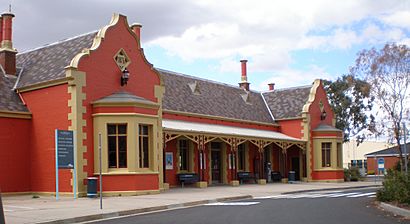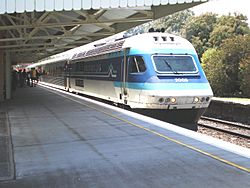Bathurst railway station, New South Wales facts for kids
Quick facts for kids
Bathurst
|
|||||||||||||||||||||
|---|---|---|---|---|---|---|---|---|---|---|---|---|---|---|---|---|---|---|---|---|---|

Station front in April 2006
|
|||||||||||||||||||||
| Location | Keppel Street, Bathurst | ||||||||||||||||||||
| Coordinates | 33°25′32″S 149°35′00″E / 33.425563°S 149.583353°E | ||||||||||||||||||||
| Owned by | Transport Asset Holding Entity | ||||||||||||||||||||
| Operated by | NSW TrainLink | ||||||||||||||||||||
| Line(s) | Main Western | ||||||||||||||||||||
| Distance | 228.70 kilometres from Central | ||||||||||||||||||||
| Platforms | 2 side (1 disused) | ||||||||||||||||||||
| Tracks | 2 | ||||||||||||||||||||
| Connections | Bus, coach | ||||||||||||||||||||
| Construction | |||||||||||||||||||||
| Structure type | Ground | ||||||||||||||||||||
| Disabled access | Yes | ||||||||||||||||||||
| Other information | |||||||||||||||||||||
| Station code | BHS | ||||||||||||||||||||
| Website | Transport for NSW | ||||||||||||||||||||
| History | |||||||||||||||||||||
| Opened | 4 April 1876 | ||||||||||||||||||||
| Traffic | |||||||||||||||||||||
| Passengers (2013) | 80 (daily) (Sydney Trains, NSW TrainLink) | ||||||||||||||||||||
| Rank | 254 | ||||||||||||||||||||
| Services | |||||||||||||||||||||
|
|||||||||||||||||||||
Bathurst railway station is a historic train station in Bathurst, Australia. It's located on the Main Western line and serves the city of Bathurst. This station is very important because of its history and unique design, and it's listed on the New South Wales State Heritage Register.
Contents
History of Bathurst Station
How the Station Started
Bathurst station first opened on 4 April 1876. This happened when the Great Western Railway, now called the Main Western line, was extended from Kelso. The Governor of New South Wales, Hercules Robinson, officially opened the station.
The main station building, a goods shed, and the station-master's house were all finished in 1876. For a short time, Bathurst was the end of the train line. Then, on 1 November 1876, the line was extended to Blayney.
Bathurst's Importance and the Railway
Before the railway, Bathurst was already a big town. It was known for its large farms and the gold rush in the 1850s. The gold rush made the town's population grow a lot. Many important buildings in Bathurst were built after the gold rush.
The idea for the first railways in New South Wales came from big landowners. They wanted better ways to transport their wool from inland towns like Bathurst. When the railway arrived, it gave Bathurst a huge boost. It made it easy and cheap for the town to trade and communicate with Sydney.
Early Railway Buildings
Over the years, many other buildings and features were added to the station area. These included:
- A Stores office around 1876.
- A coal stage in 1877 (used for loading coal onto trains).
- A new coal stage in 1878.
- A blacksmith's shop in 1878-1879.
- A turntable in 1879 (used to turn locomotives around).
- An engine shed in 1881.
- The West signal box in 1885.
Bathurst became a major railway hub. A special area for locomotives was built in 1879. By 1917, the Bathurst depot had 72 locomotives. These trains worked on the Main Western and Blayney-Demondrille lines. They also provided extra engines for steep sections of track.
Ben Chifley and the Railway
The railway workshops, built in the 1880s, created a large community of railway workers. There was even a rail institute to help educate the hundreds of workers in Bathurst.
In 1903, a young man named Ben Chifley started working at the Bathurst railway. He began as a shop boy. In 1912, he became a train driver, the youngest First Class locomotive driver at the time. Chifley stayed at the Bathurst depot until 1928. He then left to become a politician, eventually becoming the Prime Minister of Australia in 1945.
While working at the railway, Chifley went to night school and classes at the Institute. The union meetings he attended there helped shape his ideas about workers' rights and politics. He also helped start a union for locomotive drivers.
Changes Over Time
Many changes happened at the station in the late 1800s and 1900s. For example:
- Stockyards were added around 1900.
- A wagon repair shed was built in 1891.
- The platform was made longer in 1897.
- An elevated coal storage area was built in 1916.
- A refreshment room opened in 1917.
After World War II (between 1945 and 1960), Bathurst station was very busy. About 500 staff worked there. However, by the 1970s, things changed. New ways of moving freight and the switch to diesel trains meant many buildings and jobs were no longer needed.
The refreshment room closed in 1968, and the Railway Institute closed in 1975. While many old buildings are empty, some are still used. The old District Engineer's office is now a college, and the Station Master's house is rented out.
The Bathurst locomotive depot closed on 23 January 1981. All the work moved to Lithgow.
Even so, Bathurst remained important for railways. In the 1970s, a company called Clyde Engineering opened a factory in Kelso, near Bathurst. They built and repaired locomotives there. This factory closed in April 2014.
Train Services at Bathurst
Bathurst station is served by NSW TrainLink trains.
- The Bathurst Bullet runs 4 times a day to Sydney and Lithgow.
- The daily Central West XPT travels between Sydney and Dubbo.
- The weekly Outback Xplorer goes between Sydney and Broken Hill.
The weekly Indian Pacific train, run by Great Southern Rail, passes through Bathurst but does not stop here.
NSW TrainLink also runs road coach (bus) services from Bathurst station. These buses connect to places like Lithgow, Orange, Parkes, and Dubbo.
| Platform | Line | Stopping pattern | Notes |
| 1 |
NSW TrainLink
|
2 morning services Sydney Central 2 evening services to Lithgow |
|
|---|---|---|---|
|
Western Region
|
Services to Sydney Central, Broken Hill and Dubbo | ||
| 2 | Not in use |
Getting Around: Transport Links
Local buses also connect to Bathurst station.
- Bathurst Buslines routes 522, 524, and 526 stop at the station.
- Lithgow Buslines operates route 636 from Bathurst station to Lithgow.
What the Station Looks Like
The station has two platforms, but only the one on the northern side is currently used by trains.
The Main Station Building (1876)
The main station building is a fantastic example of a first-class station. It's a single-storey building made of brick with a special smooth finish. It's built in a style called Victorian Tudor. It has two parts that stick out towards the front, with fancy stone-like corners and a window that sticks out (a bay window). The parts that stick out have curved tops, and the year 1876 is clearly shown on them. The roof is made of slate, and it has unique chimneys.
The original building had a porch on the street side with decorative wooden columns and brackets. The platform side has been changed with a new roof-like structure (awning) supported by brackets. This was added when the building was extended for refreshment rooms. The main station building is a key landmark in Bathurst.
Waiting Shed (1914)
There is a simple wooden waiting shed on the other platform (the "Down" platform). It was built around 1916.
Station Master's Residence (1880)
This is a grand two-storey brick house built in the Gothic Revival style. It has a part that sticks out at the front with a bay window and a decorative plaster railing above it. The house is made of the typical red brick found in Bathurst. It has decorative corners, fancy wooden trim, and detailed designs around the windows and doors. The porch is supported by cast-iron columns and brackets. This house is one of the best examples of a station master's residence still standing in New South Wales.
Stores Branch Office
This is a smaller wooden building with a corrugated iron roof. It has a central doorway and four rooms and is now used as offices. It has a porch that wraps around one side.
Subway
There's a brick subway that used to connect the two platforms, but it's not used anymore. It has stairs leading down to a brick tunnel that goes under the tracks. It might have been built or extended when the train line was doubled in 1915.
Other Historic Items
Other important historic parts of the station area include:
- The front area and gardens leading to the station entrance.
- A weighbridge (used for weighing goods).
- A signal box (used to control train signals).
- A goods shed (for storing goods).
- A water reservoir.
Most of these buildings were in good condition as of 2013, except for the disused subway, which needed repairs. The station buildings, platforms, station master's residence, and signal box are all well-preserved.
Chifley's Locomotive
One of the locomotives that Ben Chifley drove, engine number 5112, is now on display at the eastern end of the station. It was restored to look like new at the Lithgow State Mine Heritage Park & Railway.
Why Bathurst Station is Important
Bathurst Railway Precinct is very important to the history of New South Wales. It's a major country railway area with a large, beautiful station building, a residence, and important workshop buildings.
The station building from 1876 is unique. It's a great example of a first-class railway station with its original features and fine details. The size and design of the building show how important Bathurst was as the biggest city west of the Blue Mountains. The station is at the end of Keppel Street, one of Bathurst's main streets, and its buildings form an important group in the town.
The station is also special because its design is unlike any other railway building in New South Wales. It's also important because of its connection to Ben Chifley, who became Prime Minister of Australia. His early work and education at the Bathurst Railway Precinct helped him develop his ideas about helping workers and his political beliefs.
The station is important for showing how railways developed in New South Wales in the late 1800s and early 1900s. It shows what a working railway area looked like back then.
The station is also important to the local community. It provided many jobs and was a key place for trade and social life for a long time. It helps the community feel connected to its past.
Images for kids
-
A locomotive driven by Ben Chifley is on display at the station.




